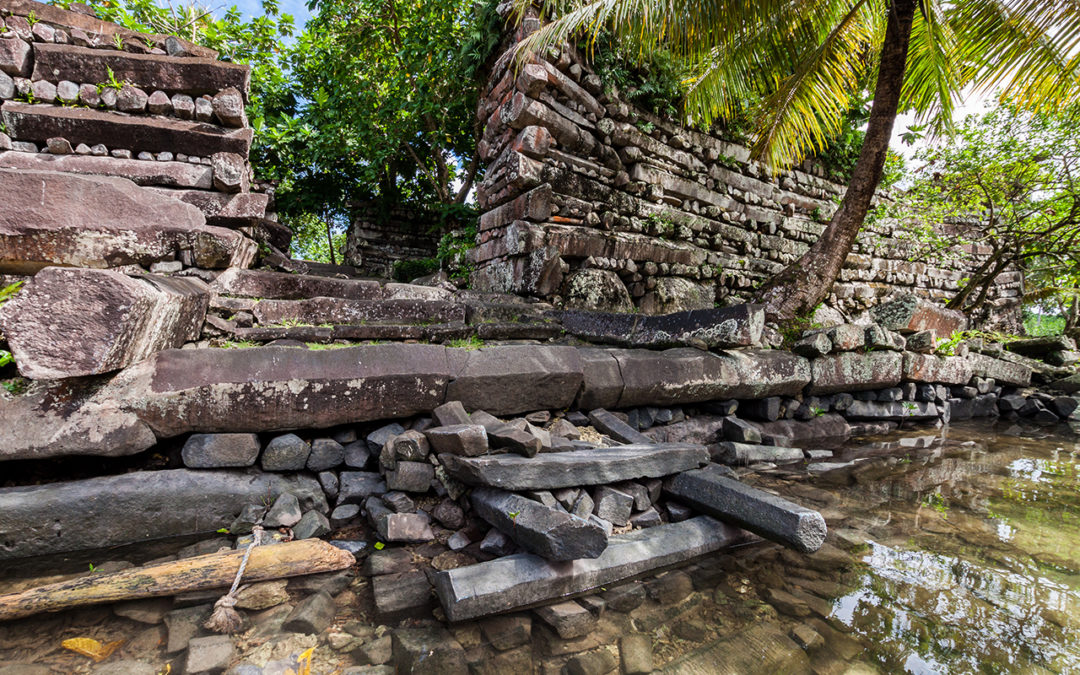Nan Madol is a series of man-made islands located in the Pohnpei island group of the Federated States of Micronesia and is often interpreted as the remains of one of the “lost continents” of Lemuria or Mu.
It is said to be the only city in the world built on top of a coral reef and is best known for its series of artificial islands built with colossal, magnetized basalt blocks.
Located in the Pacific Ocean between the equator and eleventh parallel (the birthplace of typhoons) where they develop the first stages of their power.
The hurricanes that form in the Pacific Ocean are known for their intensity.
The winds associated with these hurricanes can reach speeds of up to 250 miles per hour, and the flooding can be extremely destructive.
In addition, the hurricanes carry large amounts of water vapor, which can lead to extensive rainfall.
The storms produce powerful electrical fields, known for their destructive behavior.
The formation of hurricanes is still not fully understood, but it is believed that they are caused by a combination of factors, including heat and moisture.
The major dominating factor in producing hurricanes, however, is fundamentally electromagnetic in nature; heat is secondary.
Understanding this fact can ultimately lead to our ability to control or even mitigate hurricanes.
There have been some attempts to do this in the past, with limited success.
For example, in 1992 the US military attempted to use a high-power microwave beam to disrupt the formation of a hurricane.
The construction of Nan Madol is shrouded in mystery, and many theories abound about its origins.
One popular theory is that Nan Madol was constructed by the ancestors of the Pohnpeian people, who arrived on the island in canoes from some other, unknown location.
Another theory suggests that Nan Madol was built by the ancient Olmec people, who were known for their impressive stone architecture.
The exact purpose of Nan Madol is unknown, but it is thought that the city may have been used as a power/weather station.
Some experts believe that Nan Madol was built on top of a large coral reef, which acted as a natural generator of piezoelectricity.
Piezoelectricity is a type of electricity that is generated when certain materials are subjected to pressure or vibration.
Nan Madol may have been the first city in the world to use this type of power generation.
It’s possible that the builders of Nan Madol knew how to control hurricanes by manipulating the electromagnetic fields around Pohnpei, the island attached to Nan Madol.
If this is true, it would be an amazing example of ancient technology and engineering.
The piezoelectricity works in tandem with the strangely magnetized basalt to aim a corona electrical discharge skyward.
Nikola Tesla, the Serbian-American inventor, physicist, and electrical engineer, became interested in using rotating magnetic fields to control weather patterns.
He claimed to have designed a “weather machine” that could create hurricanes, tornadoes, and other storms by altering the Earth’s ionosphere.
Tesla theorized that thunderstorms and other storms were caused by large masses of air being displaced by the piezoelectric effects of lightning bolts.
While there is no evidence that Tesla ever built such a machine, his theories about piezoelectricity and electrostatic induction provide a plausible basis for such a device.
Even today, 12,000 years later, Nan Madol emits a strange light phenomenon seen in the Pacific Ocean.
It is said to be caused by hurricanes passing over the ocean, which create electrical charges in the water.
These charges are then said to create the light phenomenon.
Some scientists believe that the light phenomenon may also be caused by piezoelectricity – the generation of electricity from pressure or stress.
This theory is supported by the fact that many of Nan Madol’s structures are built on top of pillars, which could create vibrations in the water that would create piezoelectricity.
No one knows for sure what causes the lights at night, but it remains an interesting and mysterious phenomenon.

Who built Nan Madol?
Nan Madol was built around the turn of the first millennium by the Saudeleur Dynasty, a dynasty of kings who ruled the island of Pohnpei from about 1200 AD to 1600 AD.
The Saudeleur Dynasty was founded by Isokelekel, who allegedly arrived on Pohnpei from a place called Fayu. According to legend, Isokelekel and his followers traveled to Pohnpei in canoes and built Nan Madol as their capital. The construction of Nan Madol is said to have been financed by the discovery of large deposits of gold and other valuable minerals in the area.
Is Nan Madol a wonder of the world?
There is some debate over whether or not Nan Madol qualifies as a wonder of the world. Some people say that the site’s architecture is too simple to be considered a marvel, while others argue that the fact that it was built on a coral reef makes it a unique and impressive achievement.
What cannot be disputed, however, is Nan Madol’s place in history. The city was constructed more than 1,000 years ago and is still standing today, which makes it one of the oldest man-made structures in the world. Whether or not it’s beautiful from an architectural standpoint is up for debate, but there’s no question that Nan Madol is an amazing feat of engineering.
What is the mystery of Nan Madol?
The mystery of Nan Madol is that nobody really knows what it was used for. It’s a city of connected artificial islands made out of coral and stone, and it’s thought that it may have been used as a religious or political center. But we’re not sure, because there’s not much evidence to support any specific theory.
Some people think it was used as a burial ground, because human remains and artifacts have been found there. Others think it may have been a trading post, or a place where priests performed rituals. The truth is, we just don’t know for sure what it was used for. But it’s an amazing feat of engineering, and definitely worth checking out if you’re ever in the area.
What is Pohnpei known for?
Pohnpei is an island located in the Federated States of Micronesia. It is best known for its archaeological sites, including Nan Madol, a ruined city built on a series of artificial islands. Other attractions on Pohnpei include waterfalls, coral reefs, and rainforest.
Why is Nan Madol endangered?
Nan Madol is endangered because it is slowly eroding away.
Nan Madol is an ancient city built on a series of artificial islands. The city was constructed in the late 1200s and early 1300s, and it is now in a state of disrepair. The combination of erosion and destruction by treasure hunters has left the city in a perilous condition. If steps are not taken to preserve the site, it may eventually be lost forever.
How do you get to Nan Madol?
There is no one definitive answer to this question as there are various ways to reach the ancient city of Nan Madol. One can fly into Pohnpei and then take a taxi or bus to the ruins, or take a boat from Kolonia Harbour. There are also tour operators who offer day trips or longer tours that include visits to other sites on Pohnpei. Whichever method you choose, it’s important to be aware that there is no public transportation available on Pohnpei, so be sure to arrange for transportation in advance.
Where is Pohnpei?
Pohnpei is a state of Micronesia, located in the eastern Caroline Islands. It is one of the four states that make up the Federated States of Micronesia.
Pohnpei is located approximately 2,600 kilometers (1,615 miles) east of Manila, Philippines and 6,100 kilometers (3,795 miles) west of Honolulu, Hawaii. The nearest neighbors are the island of Kosrae to the east and the island of Chuuk to the south.

